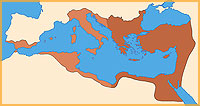|
Physical boundaries of the Empire
in the period 527-565
 By
the time Justinian I ascended to the throne (527), the Roman
Empire was limited to its eastern territory. The weakening
of the Roman power over western Europe and the barbaric invasions
of the fifth century resulted in the establishment of a series
of Germanic states: the Ostrogothic kingdom in Italy and western
Illyricum, the Visigothic kingdom in Spain, the Frankish and
Burgond kingdoms in Gaul, the Vandal kingdom in North Africa.
More barbaric tribes (Huns, Avars, Slavs, Bulgars) had less
than successfully settled beyond the Danube, the natural nothern
frontier in the Balkans, their bloody raids causing immense
havoc as far as Constantinople in the east and the Peloponnese
in the south. By
the time Justinian I ascended to the throne (527), the Roman
Empire was limited to its eastern territory. The weakening
of the Roman power over western Europe and the barbaric invasions
of the fifth century resulted in the establishment of a series
of Germanic states: the Ostrogothic kingdom in Italy and western
Illyricum, the Visigothic kingdom in Spain, the Frankish and
Burgond kingdoms in Gaul, the Vandal kingdom in North Africa.
More barbaric tribes (Huns, Avars, Slavs, Bulgars) had less
than successfully settled beyond the Danube, the natural nothern
frontier in the Balkans, their bloody raids causing immense
havoc as far as Constantinople in the east and the Peloponnese
in the south.
The conquest of the Roman west and the re-establishment
of the Roman empire as the ruler of the world was Justinian
I's greatest vision. In the period 530-550 a brief recovery
of parts of the West took place which extended the impire's
borders from Gibraltar to Mesopotamia embracing almost the
entire Mediterranean Sea and most of the Black Sea. By 560,
the empire had recovered North Africa (532-534), Italy (535-552)
and southern Spain (551). Its western territory embraced,
except the north-western provinces which were lost once and
for all, Italy, Sicily, the western Mediterranean islands
(Sardinia, Corsica, the Balears), parts of Spain, and North
Africa (Algeria, Tunisia, Libya).
Its eastern territory included the Balkans (today's
ex-Yugoslav republics, Romania, Bulgaria, Albania and Greece),
Asia Minor and part of Mesopotamia (Turkey), Syria and Palestine
(Syria, Lebanon, nothern Iraq, Israel, Jordan), and Egypt.
Beyond the Euphrates lay another great power and traditional
enemy of the Roman empire, the Persia of the Sassanids.
|